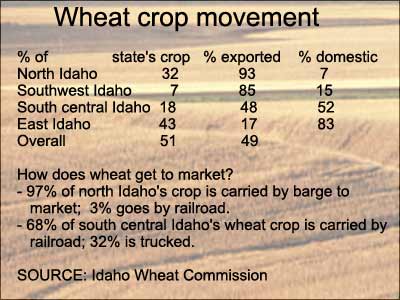forum
library
tutorial
contact

Wheat Growers Brace for River Closure
by Cindy SnyderAg Weekly, January 8, 2010
|
the film forum library tutorial contact |

|
Wheat Growers Brace for River Closureby Cindy SnyderAg Weekly, January 8, 2010 |
 COEUR d'ALENE, Idaho - They know it's a year away, but north Idaho wheat growers are already bracing for the big one that will cause transportation nightmares and is expected to have market repercussions.
COEUR d'ALENE, Idaho - They know it's a year away, but north Idaho wheat growers are already bracing for the big one that will cause transportation nightmares and is expected to have market repercussions.
Nearly all - 97 percent - of the wheat grown in north Idaho is barged down the Columbia River system to export facilities in Portland, Ore. Growers are used to the river being closed for about three weeks each March for routine maintenance, but the Corps of Engineers is planning major renovations and repairs for the system from the Dalles to Lower Monumental dam.
Starting in December 2010 and continuing through March 2011, the Columbia River system will be closed to all barge traffic for 16 weeks. That means 56.6 million bushels of wheat will have to be moved to market in a different manner.
It's a logistics conundrum that has growers, elevators, railroad managers and barge operators alike looking for solutions.
Rob Rich, spokesman for Shaver Transportation, has been operating barges on the river for 30 years. He has never seen a closure last for four months before. His company is one of two barge lines that carry grain, and grain accounts for 60 percent of Shaver's business.
One option is to load the 80 grain barges owned by the two grain hauling barge companies with wheat ahead of the closure. That would provide storage for up to 9 million bushels of the 56 million bushels that is usually moving to market during the winter months.
During the annual lock closure, Shaver usually loads most of its barges with grain and heads to Portland but leaves a few upriver to be loaded during the closure.
There is one elevator below the lock system that has the capability to handle about 1 million bu. of wheat per week. Grain producers are exploring the feasibility of trucking grain to that elevator and then barging it the rest of the way down river. Weight limits on trucks could limit the use of that facility, but if it could operate at full capacity for the 16-week closure that would allow 16 million bushels of wheat to move to market.
Add that 16 million bushels to the 9 million bushels the barge lines could potentially store still leaves 31 million bushels of wheat that will potentially have to be moved by railroad.
Union Pacific is already making plans to pre-position rail cars to help handle extra grain, said Paul Hammes, vice president for agricultural products marketing. To handle a 20 to 30 million bushel shift of wheat to the railroad will require 300 to 500 rail cars per week, he told grain producers during the Idaho Grain Producers Association's annual meeting.
"Three- to five-hundred cars per week doesn't sound like a big number, but we're really going to have to work to manage it," Hammes said.
Union Pacific is patterning its planning efforts based on the line's experiences hauling durum wheat in 2008. Growers in the Southwest harvested
2.5 times their normal crop while the North Dakota crop came in well below expectations.
"We had to move durum out of the Arizona and California and both into North Dakota and export markets. It was a very unusual pattern," he said.
Working with rail customers to determine exactly how many rail cars will be needed when and where, how many cars can a facility load in a day, how many cars can be stored onsite will become critical to meeting the extra demand.
The railroad will also be more flexible with unit train sizes to make moving wheat out of the region as efficient as possible. He is optimistic that, given the 12-month notice before the closure, a workable plan can be developed.
But growers remain concerned the long closure will not only disrupt transportation, but adversely impact prices as well. One economist asked later about the potential impact said he wouldn't be surprised to see regional prices drop by 25 cents a bushel.
Kristin Meira, government relations director for the Pacific Northwest Waterways Association, recognizes the concern but points out parts of the lock system are 50 years old. In September, the Dalles had to be closed in an emergency outage to make repairs.
Even though replacing gates and lock structures will be both lengthy and expensive, Meira expects the system to be more reliable for shippers in the long-run.
learn more on topics covered in the film
see the video
read the script
learn the songs
discussion forum
